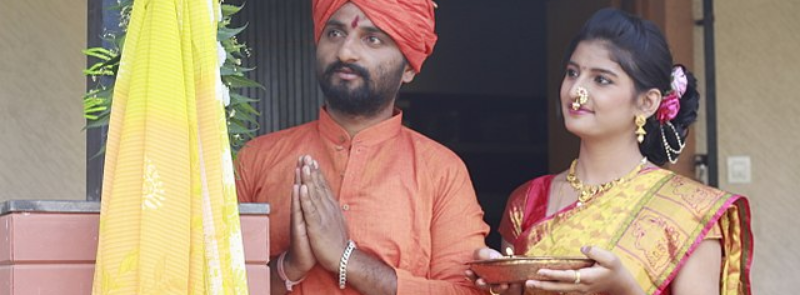
When It Occurs
Annually Start of Lunisolar Hindu Month Chaitra
Timeline
Days Passed (583)
# Hashtags
#GudiPadwa #HarvestSeason
Gudi Padwa, a spring festival, signifies the commencement of the traditional new year for Hindus, particularly those of Marathi and Konkani heritage. Celebrated in and around Maharashtra, Goa, Madhya Pradesh, and Dadra and Nagar Haveli and Daman and Diu at the onset of Chaitra, the first month of the lunisolar Hindu calendar, the festival is marked by vibrant floor decorations known as rangoli. Additionally, festivities include the display of a special gudi dvaja (a saree or cloth adorned with flowers, mango, and neem leaves, along with a garland of sugar crystals called gathi), street processions, dance performances, and the enjoyment of festive foods.
Historical and Mythological Significance:
- Creation of the Universe: According to Hindu mythology, Lord Brahma, the creator of the universe, started his work on this day, making Gudi Padwa symbolic of creation, new beginnings, and the triumph of good over evil.
- Victory of Lord Rama: It is believed that Lord Rama returned to Ayodhya after defeating Ravana on this day. The gudi represents the victory flag raised in celebration of his triumph.
- Chhatrapati Shivaji Maharaj's Victories: The festival also honors the victories of Chhatrapati Shivaji Maharaj, the Maratha warrior king, who played a key role in establishing a prosperous kingdom. The gudi is raised to commemorate his victories.
- Harvest Festival: In rural Maharashtra, Gudi Padwa is associated with the harvest season. It marks the end of the Rabi crop and the beginning of the spring season.
Gudi Padwa Rituals and Traditions:
- Raising the Gudi:
- A key element of the celebration is the raising of a gudi outside homes, typically at windows or terraces. The gudi is a bamboo stick adorned with a silk cloth, a garland of flowers, neem leaves, mango leaves, and a kalash (bronze or silver pot) placed at the top.
- The gudi represents victory, prosperity, and good fortune. It is believed to ward off evil and bring in happiness and success.
- Ritualistic Bath and New Clothes:
- The day starts with an oil bath (symbolizing purification), after which people wear new clothes, often in vibrant, festive colors. Women typically wear sarees, while men wear traditional attire such as kurta and dhoti.
- Rangoli Designs:
- Rangoli (colorful patterns made with colored powders or flowers) is drawn at the entrance of homes to invite positive energy and good luck. This is an essential part of Gudi Padwa celebrations, symbolizing prosperity.
- Special Prayers and Offerings:
- Devotees offer prayers to Lord Brahma and Lord Vishnu, seeking blessings for health, prosperity, and success in the new year.
- Temples are visited, and offerings of flowers, coconut, neem leaves, and fruits are made.
- Festive Meals:
- Special dishes are prepared, with a mix of sweet and bitter flavors to symbolize the various experiences of life. A traditional Gudi Padwa dish is Neem leaves and Jaggery, which represents the balance of bitter and sweet aspects of life.
- Popular dishes include Shrikhand-Puri, Puran Poli (sweet flatbread), Sabudana Khichdi, and various regional delicacies.
- Exchanging Greetings and Visiting Friends:
- Families and friends visit each other, exchanging sweets and greetings to mark the beginning of the new year. Gifts are also exchanged among loved ones as a sign of goodwill and celebration.
Cultural and Social Importance:
- Symbol of Renewal and New Beginnings:
- Gudi Padwa is seen as an occasion for renewal and fresh starts, both spiritually and materially. People clean and decorate their homes, start new ventures, and buy new clothes and household items.
- It is a highly auspicious day for investments, buying property, and starting new projects.
- Community Bonding and Family Gatherings:
- The festival is a time for families and communities to come together, strengthening social ties and fostering unity. Family gatherings and community events are common, with cultural performances, music, and dance adding to the festive spirit.
- Agricultural Significance:
- For farmers, Gudi Padwa is a harvest festival marking the successful reaping of the Rabi crop and preparing for the new Kharif season. Prayers are offered for good rainfall and a fruitful agricultural season ahead.
Regional Variations:
- Maharashtra (Gudi Padwa):
- The most elaborate celebrations occur in Maharashtra, where homes and streets are decorated with gudis. In villages, processions, cultural performances, and social gatherings take place to honor the festival.
- Karnataka and Andhra Pradesh (Ugadi):
- In Karnataka and Andhra Pradesh, Gudi Padwa is celebrated as Ugadi. Special Ugadi dishes include Ugadi Pachadi, a combination of six flavors representing different emotions: sweet, sour, salty, bitter, pungent, and astringent. It symbolizes the varied experiences of life.
- Sindhi Community (Cheti Chand):
- The Sindhi community celebrates Cheti Chand on the same day, marking the New Year and honoring Jhulelal, a revered saint. The festival involves religious processions, prayers, and social gatherings.
Astrological Significance:
- Gudi Padwa is also considered an auspicious time according to astrological beliefs. It marks the start of the Chaitra Navratri, a nine-day festival dedicated to Goddess Durga.
- The day is believed to be when Saturn (Shani) transitions to Aries, which is considered beneficial for starting new ventures and making important decisions.
Environmental and Health Significance:
- The traditional practice of consuming neem leaves mixed with jaggery has health benefits, as neem is known for its medicinal properties, aiding in detoxification and boosting immunity.
- The festival’s connection with the harvest season encourages people to respect and be mindful of natural resources and sustainable agricultural practices.
Conclusion:
Gudi Padwa is a vibrant celebration of new beginnings, victory, and prosperity, deeply rooted in Hindu mythology and Maharashtrian culture. Whether through the symbolic raising of the gudi, community prayers, or festive meals, the festival brings families and communities together to celebrate the start of a new year. The day’s rituals and traditions highlight the importance of spiritual renewal, gratitude, and cultural identity, making Gudi Padwa a joyful and meaningful occasion for millions across India and the world.


